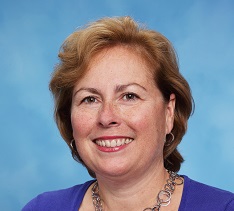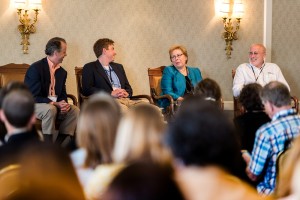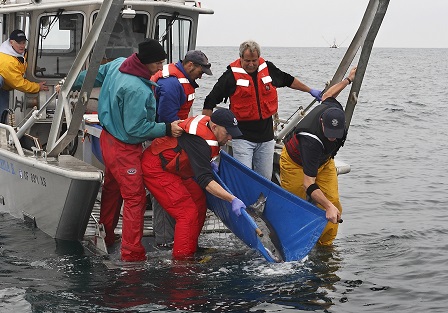By REBECCA NAGY
This article was published in the Autumn 2014 issue of Coastwatch. See the other interviews from this issue here.

Margaret Spring.
The following interview has been condensed and edited.
A 1991 Knauss fellow, Margaret Spring is vice president of conservation and science, and chief conservation officer of the Monterey Bay Aquarium in California. She directs research programs involving sea otters, great white sharks, Pacific bluefin tuna and other species. When not attending meetings and conferences for her job, Spring enjoys giving tours of the aquarium, visiting with researchers, watching veterinarians attach tracking devices to sea otters, and seeing children get excited about the ocean.
Before joining the aquarium in 2013, Spring worked for the National Oceanic and Atmospheric Administration, including roles as chief of staff and then principal deputy undersecretary for oceans and atmosphere.
Spring also worked as the senior Democratic counsel for the U.S. Senate Committee on Commerce, Science and Transportation, her fellowship host office. She has worked as the director of the California Coastal and Marine Program at The Nature Conservancy, and as an environmental attorney at Sidley and Austin in Washington, D.C. A native of New York City, Spring earned her bachelor’s degree in classical archeology from Dartmouth College and is a graduate of Duke University Law School.
The following interview has been condensed and edited.
• What was the general focus of your Knauss fellowship?
I worked on issues dealing with NOAA and the Coast Guard, including reauthorizations and oversight concerning satellite funding and failure problems, weather service operations, coastal zone management, enforcement of the high seas drift net act — basically all legislative oversight issues relating to NOAA and the Coast Guard.
• Please share a highlight or an accomplishment from your time as a fellow.

Monterey Bay Aquarium and Stanford University convened the world’s leading bluefin tuna researchers, policymakers and stakeholders for the Bluefin Futures Symposium in January 2016. Margaret, third from left, served on one of the panel discussions.
I worked for Senator Ernest Hollings, D-S.C., when the Geostationary Operational Environmental Satellite (GOES) — that basically is the eye in the sky for hurricanes — failed. Sen. Hollings was the chair of the committee and the chair of the subcommittee that appropriated funds for NOAA. I staffed him on a major oversight hearing held by the appropriations committee about how to fix the problem.
The satellite failed after Hurricane Hugo, which had devastated South Carolina. These satellites were a huge investment and were needed for safety of life and property. It was a major national crisis. I was able to help get the background information to help Sen. Hollings pull together a hearing.
I also was able to represent the committee at the negotiations on tunas in Madrid, Spain, when bluefin tuna were being proposed for listing on the Convention on International Trade in Endangered Species of Wild Fauna and Flora. I was able to be involved in negotiating major tuna treaty questions and consult with major negotiators. We’re still working on it today, even here at the aquarium.
When I returned to the U.S. Senate in 1999, my experience helped me lead efforts to create the U.S. Ocean Commission and reauthorize U.S. fishery law.
• How do you apply the experience and skills you gained as a Knauss fellow to your current position and overall career?

The Monterey Bay Aquarium’s husbandry staff releases a juvenile white shark. Photo by Randy Wilder/Monterey Bay Aquarium.
In law school, I learned to be a lawyer. What I learned as a fellow was how to go out of your comfort zone and serve in the legislature. I learned about the legislative process in a way that you would never have learned by reading about it. We got a chance to work with the agency very closely but also have a very strong impact on choices that were made to ensure, in the long run, the stability of the federal enterprise.
• What have been the greatest opportunities that have come out of the Knauss fellowship experience?
The trust you gain and the relationships you make really give you some opportunities you would not have known existed had you not been there. The fellowship changed the trajectory of my career. A lot of the work that I’ve done has teed off of the experience I had and the trust that I built in my job there.
• Would you recommend that others apply for this fellowship? Why?
I absolutely recommend it. It’s a unique fellowship. It’s hard to find your way into what a job would be like if you are interested in marine policy. The fellowship opens up a window into what it is like to work in science and policy and how they interplay. I would have never worked on Capitol Hill given my personal interests — not that I didn’t like it but because I didn’t know it. You have a lot of responsibility, whether you want it or not, and you definitely work hard. You get to meet people that you will know for the rest of your life.
For contact information and reprint requests, visit ncseagrant.ncsu.edu/coastwatch/contact/. The shortlink for this article is http://go.ncsu.edu/a14spring.
